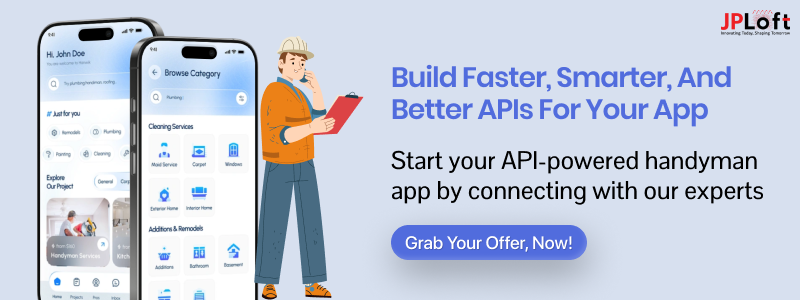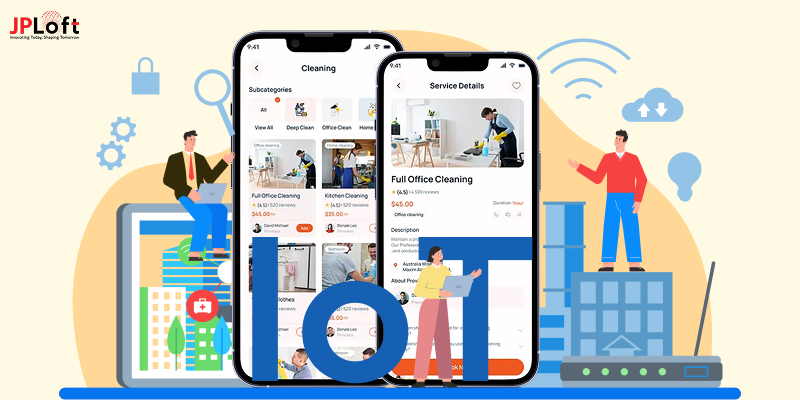With the digital era, many sectors are improving. Handyman is no more an exception. When it comes to enhancing the user experience, there are many features and third-party apps that increase overall functionality.
Can you create your handyman app without an API integration?
Absolutely yes, well, that’s where API integration for handyman apps comes into the picture. It not only helps the businesses but also improves the overall experience among the users.
Here, we will discuss it all from the concepts, market stats, to roles, types, steps, and more.
Are you ready to explore?
What is an API for Handyman Apps?
Let’s proceed with learning a brief about APIs, first.
APIs (Application Programming Interface) can be described as a set of rules that enable two diverse programs to communicate and exchange data.
These are the mechanisms that enable two software components to communicate with each other, utilizing a different set of definitions and protocols.
The APIs for handyman apps enable seamless integration with the different systems and services.
Additionally, these APIs facilitate communication between the app and external platforms, allowing features such as payment processing, location services, and scheduling.
Well, to enter the industry, it's essential to evaluate the current handyman market statistics. Let’s learn more about the same in the given points.
-
In the year 2025, the global handyman service market is estimated to be USD 530 million. Additionally, by the year 2035, it is projected to grow around USD 2,340.4 million, reflecting a CAGR of 16%.
-
The global handyman service market size worth USD 1,579.14 million by the year 2033 at a 16.5% CAGR.
-
Additionally, the on-demand handyman app market size is estimated to be USD 1.5 billion in the year 2024, which is expected to reach USD 5.2 billion by the year 2033 at a CAGR of 15.2% from the year 2026 to the year 2033.
-
Based on the data provided by Zion Market Research, the global handyman service market size was worth around USD 421.4 million by the year 2023, which is expected to grow to around USD 1,197.10 million by the year 2032 at a CAGR of 12.30% between the years 2024 and the year 2032.
These growing handyman app trends represent the increasing users’ needs and their demands.
The revenue generation via handyman apps is not only through features, but there are various other factors, and one of them is API Integration.
However, the integration of third-party services is always a risk when it comes to handyman apps.
Wondering how you can achieve success in the same? Let’s discover it all in the proceeding sections below.
Role of APIs in Handyman Apps
Haven’t you proceeded with the payment sections while dealing with any e-commerce or on-demand apps?
Well, there comes the significant role of APIs in the handyman apps.
Let’s discover a complete list to evaluate the role of API integration in handyman apps.
A] Enhances user Experience
Don’t you think, when you provide all the essential services under one roof to your customer, they will go elsewhere?
Well, this is the significance of using an API for handyman apps. The more features and convenience you provide, the higher your brand retention rate will be.
B] Ensures Scalability
An API integration in handyman apps ensures the scalability and flexibility of the apps. It enables your web app to scale up more easily.
A scalable API in the handyman apps can adapt to the diversified levels of traffic by keeping the system responsive and available.
C] Cross-Platform Compatibility
API integration allows cross-platform compatibility with the ability of cybersecurity and antivirus software to work seamlessly across diversified platforms and devices.
With this integration, you can interact with your target audience seamlessly and will be able to create a responsive design.
D] Increased Efficiency and Productivity
Through API integration, you can automate repetitive tasks such as scheduling appointments, sending reminders, and generating invoices, as well as freeing up time for other tasks.
With the help of API integration, you can improve the complete productivity of your app. It further helps in data sharing and improves communication with potential users.
E] Scheduling and Task Management
With API integration in the handyman apps, users can be able to schedule bookings as per their preferences. It will help in optimizing the app and improving its functionality.
It will further help enable applications to communicate and share data through streamlining the workflows. This will enhance collaboration among the users and the businesses.
These were the benefits of API integration in the handyman apps.
Well, it's time to evaluate the different elements of APIs to integrate into a handyman app.
Types of APIs to Integrate in a Handyman App
What are the different types of APIs to integrate into the handyman app?
When you enter the handyman app industry, one of the significant parameters you will come across is API Integration.
Let’s evaluate some of the different types of APIs that you can integrate as below.
1. Payment Processing APIs
The payment processing APIs are the tools that enable applications and websites to effectively integrate with the payment processing services.
This integration will help the users to proceed with the payment procedure. It might increase the overall cost to build a handyman app, but it will help your users to connect with payment services and to quickly book the same.
The payment processing APIs act as intermediaries, which allow businesses to accept payments without requiring them to manage complex payment infrastructure for constantly updating with new payment methods.
2. Geolocation APIs
The Geolocation APIs allow web applications to access a user’s location information, such as latitude and longitude coordinates.
Furthermore, these APIs provide a defined way to determine a device’s location using diversified methods such as GPS, WiFi, or cell towers, useful for detecting the current location.
These can be defined as the communication interfaces that allow web applications and mobile apps to access the user’s location information.
3. Communication APIs
Communication APIs allow developers to integrate communication features within the app, such as voice calling, messaging, and video chat, within their applications more easily than building them from scratch.
Here, you can include push notifications as a feature for sending real-time updates to the users related to job statuses, availability of the handymen, and any special offers.
The important role of the communication APIs is to engage the users and connect them throughout the app. Along with this, it is an important parameter to connect a diversified audience over the platform.
4. Social Login APIs
Social login APIs include the platforms over which users can directly share the related vacancy or booking details with their family or friends.
Under this platform, you should integrate APIs like Google Auth or Facebook Login to assist the users to log in using their existing social accounts, through streamlining the sign-up procedure.
This is an important third-party integration procedure that provides developers with structured access to platform data and functionality, allowing for efficient data collection, automation, and integration.
5. Scheduling and Booking APIs
The scheduling and booking APIs are the interfaces that allow applications to automate the process of scheduling appointments, managing events, and booking services.
Different aspects of scheduling and booking APIs are functionality, integration, customization, real-time updates, automation, and efficiency.
It facilitates seamless integration between diversified software systems. This helps the developers to run the API requests at specific intervals or times, daily, weekly, or even monthly.
6. Reviews and Rating APIs
You should integrate APIs to enable users to rate and review handyman services, building trust and reputation for the service providers.
This is the type of API that helps to access and retrieve data, fetch reviews, and other related information from diversified platforms.
With this API integration, you allow the developers to submit and manage reviews within their own applications and platforms.
These were certain API integrations that you can implement in the handyman app for smooth functioning. Additionally, the selection of these APIs wisely can be helpful in a handyman app's monetization.
Now, the question that arises is “ how to proceed with API Integration in the handyman app?
Let’s explore more in the section below.
Step-Wise API Integration Process
How to Integrate APIs in the Handyman App?
Well, you know that to build a handyman app, it's important to fix the APIs.
Hence, let’s learn the following steps for more information.
Step 1: Explore the Current Market
It is the foremost step when it comes to integrating APIs in the handyman apps. Here, you need to know about the market and find out about the related demands of the targeted users.
Here, you should focus on understanding the evolving landscape of API driven marketing and the latest APIs to integrate in your dream handyman app.
Additionally, you need to consider the importance of API security, API management platforms, and developer engagement for the successful API integration.
Step 2: Define the Integration Requirements
It's important to hire dedicated developers to evaluate what type and how many API integrations are crucial for your handyman app.
Here, you need to identify the type of services that your handyman app requires, such as payment gateways, maps, and booking systems.
All you need here is to define the related integration and how it's expected to function, encompassing both high-level and detailed specifications.
Step 3: Select the Right APIs
Now, you are required to select the right APIs that are reliable, scalable, and well-documented. Under this section, you should assess the API’s documentation, SDKs, and support for your programming languages and frameworks.
Here, you can select REST, SOAP, gRPC protocol, and GraphQL. Along with this, you should consider API types such as Public APIs, Partner APIs, Composite APIs, and many others.
You should discuss it with your team, and then needs to provide clear documentation, easy-to-use SDKs, and robust support for the popular frameworks and programming languages.
Step 4: Set Up API Keys & Authentication
Register with the API provider and obtain API keys or tokens, and implement proper authentication methods like OAuth2 or API keys for secure access. With the help of a leading mobile app development company in Denver, you can select the top keys.
Additionally, you should assess the functionality and other important requirements for your app after defining your needs, considering APIs' capabilities, as well as exploring different API categories.
It's essential to implement key APIs to protect the data and prevent unauthorized access. Here ,all you require is to evaluate the project aim and objectives and then select the top APIs.
Step 5: Frontend Integrations
Connect the frontend with the backend to enable real-time functionality (like location tracking, booking confirmation, etc.). This will improve the overall handyman app design selection for your app.
The frontend code fetches the data and may send the user actions via API to the backend, which handles the actual processing systems and data storage.
Within the frontend integrations, you should opt for UI/UX that helps to address user needs and create an integrated platform.
Step 6: Backend Configuration
Now, it's time to opt for backend configuration for your APIs. It's the step that comprises selecting a handyman app tech stack for creating APIs.
The API authentication and security setup includes generating and storing API keys or tokens, implementing OAuth 2.0 or JWT for secure access.
Data parsing and transformation will include JSON or XML responses from APIs, transforming the data formats to match your database needs.
Step 7: Test and Monitor
Well, you should proceed with mobile app testing, which will include monitoring tools to track API performance, uptime, and failure rates. Optimize calls to reduce latency and improve app efficiency.
This is an important step where you need to effectively test and monitor API integrations. A multi-faceted approach is needed, including comprehensive testing strategies, where you can create diverse test cases.
You can conduct a mock server, which may simulate the behavior of other systems to isolate and test API integrations without relying on any inputs and scenarios.
These were the important steps to consider while proceeding with the API Integration for handyman apps.
Well, when you create your dream app, there can be a certain number of challenges that you might face. Let’s learn about all of them in the following section.
What are the Challenges Faced While Integrating APIs in Handyman Apps?
Yes, there can be challenges in creating a handyman app if you aren’t aware of the issues about API integration.
Well, to develop a successful key handyman app, you might need to explore these challenges in implementing APIs in handyman apps.
Let’s evaluate the following points for more information.
► Complexity of API Ecosystem
If the API system that you are integrating into the handyman apps is complex, then it will take more time.
Along with this, it is challenging due to the vast and diverse landscape of the availability of APIs.
Additionally, it will impact the complete development costs, security, and overall user experience.
► Data Mapping Errors
Another challenge that your app might face is related to data mapping and error detection.
Data inconsistencies can arise from incorrect data mapping or transformations.
Thus, ensuring data accuracy and consistency across the integrated systems is crucial for reliable functionality.
► Partnership Challenges
Building and maintaining integrations with the external partners can be complex and require careful collaboration.
Managing the complex documentation, ensuring consistent data formatting, and addressing potential security and compliance issues.
Integrating with the larger organizations might require formal partnership agreements, which can be time-consuming, resource-intensive, and potentially expensive.
► API Documentation
When you connect with diversified third parties, it can hinder development and integration challenges.
This challenge can arise from inconsistency, lack of real-world examples, and difficulty in accessing test or live systems, hindering developers' ability to effectively integrate the API.
The lack of comprehensive and up-to-date documentation will result in complexity while operating the app.
► Versioning Issues
Managing versioning issues is one of the complicated challenges that your app might face.
API versioning can help manage changes to APIs by minimizing disruptions to customers.
This issue can lead to instability, poor compatibility, flexibility, and communication.
These were the top challenges faced while API integration in handyman apps.
Now, it's time to find appropriate practices to include for API integration in the handyman apps.
Top Practices to Include For API Integration in Handyman Apps
When you start an online handyman business, it's compulsory to know the essential practices.
Additionally, if you want to become one step ahead of your competitors, it's essential to identify the practices that you want to include for API integration in handyman apps.
Let’s explore them all below.
A] Comprehensive Documentation
If you want to have a smooth documentation procedure, it's essential to opt for comprehensive documentation.
It ensures smooth collaboration between teams, which minimizes miscommunication among the teams.
B] Scalability Planning
While proceeding with the API integration, it's a vital strategy as it helps to make the app more reliable, functional, and fast based on the growing user base.
Additionally, it supports feature expansion. Over time, you might want to add more APIs for chat support, advanced analytics, and multi-city operations.
C] Error Handling
Implement robust error-handling mechanisms to gracefully manage API errors and provide user-friendly feedback.
You can gracefully handle errors, where the app can display information messages to the user instead of displaying generic error messages.
D] Clear Communication With API Handling
API integration helps in promoting clear communication among the users.
Thus, you should opt for effective technologies while implementing the API, and it must be optimized.
You should maintain open communication with the API providers for addressing any issues or changes which might impact the integration procedure.
E] Rigorous Testing
Well, you should opt for API integration and test it rigorously to identify whether its working optimally in the app or not.
It does involve multiple stages, including security tests and functional performance.
Additionally, the functional testing verifies that Handyman app features like booking, messaging, and payments work efficiently.
These were the top practices to include while proceeding with API integration in handyman apps.
Are you still confused about API integration? Want to look for some examples?
The given section awaits.
Case Studies: Examples of Top Apps API Integration
Considering the top handyman apps can help identify what software is implementing or is seeking API integration.
Here, you can evaluate the diversified cases. Let’s learn them all.
Case Study 1: Thumbtack
-
APIs Used: Google Maps API (location services), Stripe API (payments), Twilio (SMS notifications)
-
Functionality: Connects users with local professionals across a variety of services, using smart matching and real-time job updates. However, this integration impacts the overall cost to develop an app like Thumbtack.
Case Study 2: TaskRabbit
-
APIs Used: Identity verification APIs, payment gateway APIs, and scheduling APIs.
-
Functionality: Allows users to book vetted professionals for tasks like furniture assembly, cleaning, and minor repairs. API integration enables real-time task tracking and secure payments. This integration can increase the cost to build an app like TaskRabbit which might vary from $20,000 to $100,000.
Case Study 3: UrbanClap (now Urban Company)
-
APIs Used: Payment APIs, chat APIs, Google Maps API, and rating/review APIs.
-
Functionality: Offers a wide range of at-home services. Effective API use ensures smooth booking, tracking, and post-service feedback. Want to build an app like Urban Company? Well, a list of prompt strategies can help.
Case Study 4: Handy
-
APIs Used: Twilio for messaging, Stripe for payments, third-party calendar APIs for scheduling. These APIs increase the cost to develop an app like Handy, but help users to access the app.
-
Functionality: Offers cleaning and handyman services with seamless integration between service providers and customers via automated workflows.
Case Study 5: Angi (formerly Angie’s List)
-
APIs Used: Custom CRM and booking APIs, financial transaction APIs.
-
Functionality: Allows users to find and hire local contractors and professionals with transparent pricing and verified reviews, supported by strong API-based data handling.
Case Study 6: Housejoy
-
APIs Used: Google Maps API, SMS APIs, payment gateway APIs.
-
Functionality: Provides home services like plumbing, carpentry, and appliance repairs. APIs help manage real-time location tracking, secure payments, and service dispatching.
Case Study 7: Porch
-
APIs Used: Zillow API (for property insights), contractor management APIs.
-
Functionality: Integrates home services directly with home purchase processes using deep API integrations for home data, contractor matching, and estimates.
Case Study 8: Zimmber (acquired by Quikr)
-
APIs Used: Payment and location APIs, communication APIs.
-
Functionality: Focused on home maintenance and repair services with strong backend support through effective API-driven workflows.
Searching for an experienced team of experts to develop your customized app?
How JPLoft Can Help in API Integration for Handyman Apps?
Wondering about creating your dream app?
Well, connect with JPLoft and identify the top APIs that you might integrate with the handyman apps.
We are the leading Handyman App Development company, whose developers are ready to evaluate the current market for your app, and to add important features within the same.
Our team can help you in determining the potential users and even the market niche to improve your market position in this competitive environment.
Conclusion
API integration is the cornerstone of building a high-performing handyman app that meets modern user expectations.
By enabling seamless communication between your app and third-party services, APIs enhance functionality, improve user experience, and streamline operations such as payments, scheduling, and communication.
From selecting the right APIs to rigorous backend configuration and testing, each step is vital for smooth integration. As the handyman app market continues to grow, ensuring scalability, robust documentation, and strong security practices will future-proof your platform.
With smart API choices and expert implementation, your handyman app can stand out in a competitive, fast-evolving digital landscape.
FAQs
API integration connects external services (like payments or GPS) to handyman apps, enabling better features, scalability, and a smoother user experience.
APIs enhance booking, navigation, payments, and messaging, making the app more user-friendly and efficient.
Developers may face issues like poor documentation or data errors. These can be reduced by choosing reliable APIs, testing well, and using skilled developers.
Plan the integration, choose the right APIs, ensure secure setup, test thoroughly, and monitor performance after launch.
Use clear documentation, plan for growth, handle errors properly, test rigorously, and maintain communication with API providers.












Share this blog